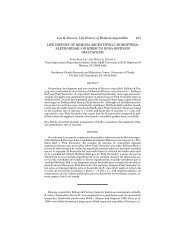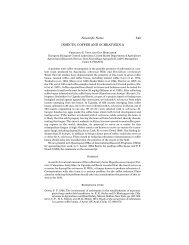evaluation of commercial pheromone lures and traps
evaluation of commercial pheromone lures and traps
evaluation of commercial pheromone lures and traps
You also want an ePaper? Increase the reach of your titles
YUMPU automatically turns print PDFs into web optimized ePapers that Google loves.
660<br />
been shown to be a useful tool for monitoring<br />
FAW males (Adams et al. 1989; Mitchell et al.<br />
1989; Gross & Carpenter 1991). The efficacy <strong>of</strong><br />
these <strong>commercial</strong> sex <strong>pheromone</strong>s towards Mexican<br />
populations <strong>of</strong> FAW is largely unknown.<br />
Gutiérrez-Martínez et al. (1989) evaluated <strong>lures</strong><br />
but did not report the source <strong>of</strong> <strong>lures</strong>. This study<br />
was therefore undertaken to evaluate the capture<br />
<strong>of</strong> <strong>commercial</strong> <strong>pheromone</strong> formulations <strong>and</strong> trap<br />
designs as a first step for developing a system for<br />
monitoring FAW in Mexican maize crops.<br />
Study Area<br />
MATERIALS<br />
AND METHODS<br />
Trials were performed during the late summer<br />
growing cycle <strong>of</strong> 1998 <strong>and</strong> 1999. Both trials were<br />
conducted in the municipality <strong>of</strong> Suchiate (14°<br />
42’N,<br />
92°<br />
16’W), Chiapas, in maize fields planted with<br />
Cristiani Burkard hybrid (1998) or TACSA 2000<br />
hybrid (1999) sown at the usual density <strong>of</strong> 50,000<br />
plants per ha with a 0.75 m row spacing.<br />
1998 Trial<br />
Three <strong>commercial</strong>ly available FAW sex <strong>pheromone</strong><br />
<strong>lures</strong> <strong>and</strong> two trap designs were evaluated in<br />
a 2 × 4 factorial design. The treatments were arranged<br />
in a fully r<strong>and</strong>omized block design with<br />
four replicates <strong>of</strong> each treatment. The replicate<br />
blocks were arranged in parallel lines approximately<br />
30 m apart within the field (5 ha). The <strong>lures</strong><br />
tested were Scentry (Scentry Inc., Buckeye, Ariz.),<br />
a grey rubber septum dispenser; Trécé (Trécé Inc.,<br />
Salinas, Calif.) a red rubber septum dispenser, obtained<br />
through Gempler’s Inc., Belleville, WI,<br />
(USA); <strong>and</strong> Chemtica, a bubble cap (Chemtica,<br />
Heredia, Costa Rica). Traps without <strong>lures</strong> were<br />
used as a control. The <strong>traps</strong> evaluated were the<br />
Scentry Heliothis trap, a white double cone collapsible<br />
plastic net (Ecogen Inc. Billings, MT); <strong>and</strong><br />
a green reusable bucket trap (Gempler`s,<br />
Belleville, WI). Traps with the <strong>lures</strong> were hung approximately<br />
1.5 m above the ground on wooden<br />
stakes placed at 30 m intervals along planted rows.<br />
The <strong>traps</strong> were placed on 18 July, when the maize<br />
plants were 15 d old, <strong>and</strong> they remained in place<br />
over the two- month trial. All <strong>lures</strong> were changed<br />
monthly. Trap captures were recorded every 3-4 d<br />
from 18 July to 3 September, a total <strong>of</strong> 16 observation<br />
dates. However, at end <strong>of</strong> the trial, male capture<br />
was very low (3 FAW males in total), <strong>and</strong> for<br />
this reason the last two observation dates were not<br />
included in the statistical analysis. On each date,<br />
we emptied the <strong>traps</strong> <strong>and</strong> recorded the numbers <strong>of</strong><br />
FAW males <strong>and</strong> non-target insects captured. All<br />
non-target insects captured were identified to order<br />
(Borror et al. 1989). Voucher specimens were<br />
placed in the insect collection held at El Colegio de<br />
la Frontera Sur, Tapachula, Mexico.<br />
Florida Entomologist 84(4) December 2001<br />
1999 Trial<br />
The second experiment evaluated four <strong>commercial</strong><br />
FAW <strong>pheromone</strong> <strong>lures</strong>, which were Scentry,<br />
Trécé, Chemtica <strong>and</strong> Pherotech (Pherotech,<br />
Delta, BC) <strong>and</strong> three trap designs, Scentry Heliothis,<br />
bucket <strong>and</strong> white delta plastic (Pherotech,<br />
Delta, BC) arranged in a 3 × 5 factorial design.<br />
The <strong>traps</strong> were placed one day after planting at 1<br />
m above the ground in the first month, at 1.5 m in<br />
the second month <strong>and</strong> at 2 m in the third month.<br />
Traps were checked as described above <strong>and</strong> a total<br />
<strong>of</strong> 14 observation dates were recorded, although<br />
the last three observation dates were not<br />
analyzed because no FAW males were caught.<br />
Collection <strong>of</strong> Volatiles<br />
Volatiles emitted by the <strong>pheromone</strong> <strong>lures</strong> were<br />
collected by using the dynamic headspace (airentrainment)<br />
technique (Heath & Manukian<br />
1992). New <strong>lures</strong> (unaged) were individually confined<br />
in a 100 ml glass entrainment container (4.8<br />
cm ID × 12.5 cm height). Volatiles were drawn<br />
from the container, using purified air that had previously<br />
passed through an activated charcoal trap,<br />
onto a glass volatile collection trap (4 mm ID × 40<br />
mm long) containing 50 mg <strong>of</strong> Super Q adsorbent<br />
(Alltech Associates, Deerfield, IL, USA) (Heath &<br />
Manukian 1992). Air was drawn through the trap<br />
at a rate <strong>of</strong> 1 liter/min by a vacuum pump. The volatiles<br />
were collected for a period <strong>of</strong> 5 h. Volatiles<br />
were eluted from the adsorbent with 100 μl <strong>of</strong> methylene<br />
chloride (Baker, HPLC grade), <strong>and</strong> 100 ng<br />
<strong>of</strong> octyl acetate was added as an internal st<strong>and</strong>ard<br />
for subsequent quantification. The collection <strong>of</strong><br />
volatiles was replicated 5 times.<br />
Chemical Analysis<br />
Gas chromatographic-mass spectrometry (GC-<br />
MS) was performed with a Varian Saturn III,<br />
equipped with a DB5-MS column (30 m × 0.25<br />
mm). Gas chromatographic conditions were as follows:<br />
Injector temperature, 200°C; column temperature,<br />
isothermal at 80°C for one minute, then<br />
increasing to 250°C at 8°C/min <strong>and</strong> held at this<br />
temperature for 3 min. The mass spectrum was obtained<br />
at 70 eV by electronic impact. The chemical<br />
identification was made by comparing the spectra<br />
<strong>and</strong> the retention times <strong>of</strong> the natural products<br />
with those <strong>of</strong> authentic synthetic st<strong>and</strong>ards.<br />
Statistical Analysis<br />
The number <strong>of</strong> FAW males captured per trap<br />
per sample period in both years were converted to<br />
percent <strong>of</strong> moths captured by each trap <strong>and</strong> lure<br />
combination within each block (Mitchell et al.<br />
1985). Percentage values were arcsine <strong>of</strong> square<br />
root transformed to increase the homogeneity <strong>of</strong>






